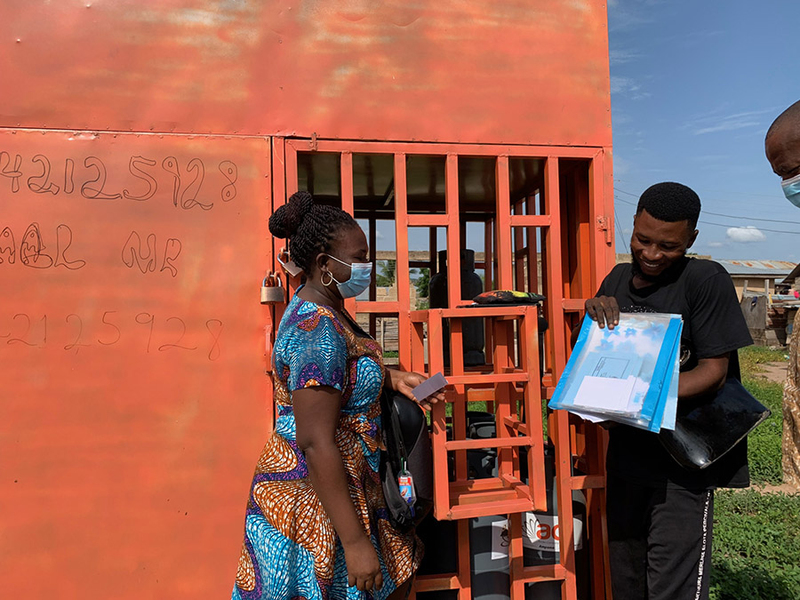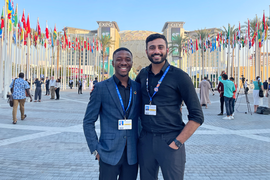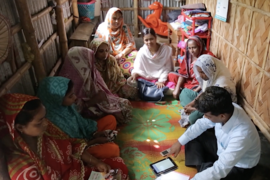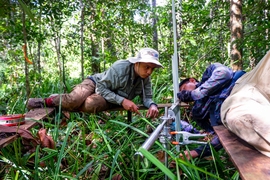The King Climate Action Initiative (K-CAI) is the flagship climate change program of the Abdul Latif Jameel Poverty Action Lab (J-PAL), which innovates, tests, and scales solutions at the nexus of climate change and poverty alleviation, together with policy partners worldwide.
Claire Walsh is the associate director of policy at J-PAL Global at MIT. She is also the project director of K-CAI. Here, Walsh talks about the work of K-CAI since its launch in 2020, and describes the ways its projects are making a difference. This is part of an ongoing series exploring how the MIT School of Humanities, Arts, and Social Sciences is addressing the climate crisis.
Q: According to the King Climate Action Initiative (K-CAI), any attempt to address poverty effectively must also simultaneously address climate change. Why is that?
A: Climate change will disproportionately harm people in poverty, particularly in low- and middle-income countries, because they tend to live in places that are more exposed to climate risk. These are nations in sub-Saharan Africa and South and Southeast Asia where low-income communities rely heavily on agriculture for their livelihoods, so extreme weather — heat, droughts, and flooding — can be devastating for people’s jobs and food security. In fact, the World Bank estimates that up to 130 million more people may be pushed into poverty by climate change by 2030.
This is unjust because these countries have historically emitted the least; their people didn’t cause the climate crisis. At the same time, they are trying to improve their economies and improve people’s welfare, so their energy demands are increasing, and they are emitting more. But they don’t have the same resources as wealthy nations for mitigation or adaptation, and many developing countries understandably don’t feel eager to put solving a problem they didn’t create at the top of their priority list. This makes finding paths forward to cutting emissions on a global scale politically challenging.
For these reasons, the problems of enhancing the well-being of people experiencing poverty, addressing inequality, and reducing pollution and greenhouse gases are inextricably linked.
Q: So how does K-CAI tackle this hybrid challenge?
A: Our initiative is pretty unique. We are a competitive, policy-based research and development fund that focuses on innovating, testing, and scaling solutions. We support researchers from MIT and other universities, and their collaborators, who are actually implementing programs, whether NGOs [nongovernmental organizations], government, or the private sector. We fund pilots of small-scale ideas in a real-world setting to determine if they hold promise, followed by larger randomized, controlled trials of promising solutions in climate change mitigation, adaptation, pollution reduction, and energy access. Our goal is to determine, through rigorous research, if these solutions are actually working — for example, in cutting emissions or protecting forests or helping vulnerable communities adapt to climate change. And finally, we offer path-to-scale grants which enable governments and NGOs to expand access to programs that have been tested and have strong evidence of impact.
We think this model is really powerful. Since we launched in 2020, we have built a portfolio of over 30 randomized evaluations and 13 scaling projects in more than 35 countries. And to date, these projects have informed the scale ups of evidence-based climate policies that have reached over 15 million people.
Q: It seems like K-CAI is advancing a kind of policy science, demanding proof of a program’s capacity to deliver results at each stage.
A: This is one of the factors that drew me to J-PAL back in 2012. I majored in anthropology and studied abroad in Uganda. From those experiences I became very passionate about pursuing a career focused on poverty reduction. To me, it is unfair that in a world full of so much wealth and so much opportunity there exists so much extreme poverty. I wanted to dedicate my career to that, but I'm also a very detail-oriented nerd who really cares about whether a program that claims to be doing something for people is accomplishing what it claims.
It's been really rewarding to see demand from governments and NGOs for evidence-informed policymaking grow over my 12 years at J-PAL. This policy science approach holds exciting promise to help transform public policy and climate policy in the coming decades.
Q: Can you point to K-CAI-funded projects that meet this high bar and are now making a significant impact?
A: Several examples jump to mind. In the state of Gujarat, India, pollution regulators are trying to cut particulate matter air pollution, which is devastating to human health. The region is home to many major industries whose emissions negatively affect most of the state’s 70 million residents.
We partnered with state pollution regulators — kind of a regional EPA [Environmental Protection Agency] — to test an emissions trading scheme that is used widely in the U.S. and Europe but not in low- and middle-income countries. The government monitors pollution levels using technology installed at factories that sends data in real time, so the regulator knows exactly what their emissions look like. The regulator sets a cap on the overall level of pollution, allocates permits to pollute, and industries can trade emissions permits.
In 2019, researchers in the J-PAL network conducted the world’s first randomized, controlled trial of this emissions trading scheme and found that it cut pollution by 20 to 30 percent — a surprising reduction. It also reduced firms’ costs, on average, because the costs of compliance went down. The state government was eager to scale up the pilot, and in the past two years, two other cities, including Ahmedabad, the biggest city in the state, have adopted the concept.
We are also supporting a project in Niger, whose economy is hugely dependent on rain-fed agriculture but with climate change is experiencing rapid desertification. Researchers in the J-PAL network have been testing training farmers in a simple, inexpensive rainwater harvesting technique, where farmers dig a half-moon-shaped hole called a demi-lune right before the rainy season. This demi-lune feeds crops that are grown directly on top of it, and helps return land that resembled flat desert to arable production.
Researchers found that training farmers in this simple technology increased adoption from 4 percent to 94 percent and that demi-lunes increased agricultural output and revenue for farmers from the first year. K-CAI is funding a path-to-scale grant so local implementers can teach this technique to over 8,000 farmers and build a more cost-effective program model. If this takes hold, the team will work with local partners to scale the training to other relevant regions of the country and potentially other countries in the Sahel.
One final example that we are really proud of, because we first funded it as a pilot and now it’s in the path to scale phase: We supported a team of researchers working with partners in Bangladesh trying to reduce carbon emissions and other pollution from brick manufacturing, an industry that generates 17 percent of the country’s carbon emissions. The scale of manufacturing is so great that at some times of year, Dhaka (the capital of Bangladesh) looks like Mordor.
Workers form these bricks and stack hundreds of thousands of them, which they then fire by burning coal. A team of local researchers and collaborators from our J-PAL network found that you can reduce the amount of coal needed for the kilns by making some low-cost changes to the manufacturing process, including stacking the bricks in a way that increases airflow in the kiln and feeding the coal fires more frequently in smaller rather than larger batches.
In the randomized, controlled trial K-CAI supported, researchers found that this cut carbon and pollution emissions significantly, and now the government has invited the team to train 1,000 brick manufacturers in Dhaka in these techniques.
Q: These are all fascinating and powerful instances of implementing ideas that address a range of problems in different parts of the world. But can K-CAI go big enough and fast enough to take a real bite out of the twin poverty and climate crisis?
A: We're not trying to find silver bullets. We are trying to build a large playbook of real solutions that work to solve specific problems in specific contexts. As you build those up in the hundreds, you have a deep bench of effective approaches to solve problems that can add up in a meaningful way. And because J-PAL works with governments and NGOs that have the capacity to take the research into action, since 2003, over 600 million people around the world have been reached by policies and programs that are informed by evidence that J-PAL-affiliated researchers produced. While global challenges seem daunting, J-PAL has shown that in 20 years we can achieve a great deal, and there is huge potential for future impact.
But unfortunately, globally, there is an underinvestment in policy innovation to combat climate change that may generate quicker, lower-cost returns at a large scale — especially in policies that determine which technologies get adopted or commercialized. For example, a lot of the huge fall in prices of renewable energy was enabled by early European government investments in solar and wind, and then continuing support for innovation in renewable energy.
That’s why I think social sciences have so much to offer in the fight against climate change and poverty; we are working where technology meets policy and where technology meets real people, which often determines their success or failure. The world should be investing in policy, economic, and social innovation just as much as it is investing in technological innovation.
Q: Do you need to be an optimist in your job?
A: I am half-optimist, half-pragmatist. I have no control over the climate change outcome for the world. And regardless of whether we can successfully avoid most of the potential damages of climate change, when I look back, I'm going to ask myself, “Did I fight or not?” The only choice I have is whether or not I fought, and I want to be a fighter.









